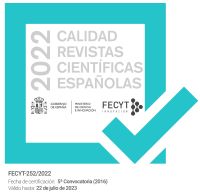The “Religious Dimension” of J.-L. Marion’s Phenomenology of Givenness
DOI:
https://doi.org/10.5944/endoxa.40.2017.17001Keywords:
giro teológico, Martin Heidegger, Jean-Luc MarionAgencies:
Universidad de Buenos AiresAbstract
Can we speak about a «theological turn» in Jean-Luc Marion’s phenomenology? Is Dominique Janicaud’s accusation relevant? Does it still maintain any validity? We should respond that Janicaud’s diagnosis is correct and at the same time, it is not. Th e is a «religious dimension» in the phenomenology of givenness, but this should not be read as an obstacle to the phenomenological task. This article aims to establish how this «religious dimension» operates in Marion’s proposal.Downloads
References
ARISTÓTELES (1982), Metafísica, trad. T. Calvo Martínez. Madrid: Gredos.
BREJDAK, J. (1996). Philosophia Crucis. Heideggers Beschäftigung mit dem Apostel Paulus. Frankfurt am Main: Peter Lang Verlag.
CAMILLERI, S. (2008). Phénoménologie de la religion et herméneutique théologique dans la pensée du jeune Heidegger. Commentaire analytique des Fondaments philosophiques de la mystique médiévale (1916-1919). Dordrecht: Springer.
CAPUTO, J. D. (1999). “Towards a postmodern Theology of the Cross. Augustine, Heidegger, Derrida”. Ed. Westphal, M. Postmodern Philosophy and Christian Thought. Bloomington: Indiana University Press.
CHRETIEN, J.-L. (1992). L’appel et la réponse. Paris: Éditions de Minuit.
FALQUE, Emmanuel (2007). «Larvatus pro Deo. Jean-Luc Marion’s Phenomenology and Theology». Ed. Hart, K. Counter-experiences. Reading Jean-Luc Marion. Notre Dame: University of Notre Dame Press.
FEHÉR, I. M. (1996-97). «Heidegger’s understanding of the atheism of philosophy: philosophy, theology, and religion on his way to Being and Time». Existentia, Vol. VI-VII, Fasc. 1-4, pp. 33-64.
GADAMER, H.-G. (1981). «Die religiöse Dimension». Gesammelte Werke. Band 3: Neuere Philosophie: Hegel, Husserl, Heidegger. Tübingen: J. C. B. Mohr Verlag, 1987.
GONDEk, H.-D. / TENGELYI, L. (2011). Neue Phänomenologie in Frankreich. Berlin: Suhrkamp.
GREISCH, J. (2000). L’arbre de vie et l’arbre du savoir. Le chemin phénoménologique de l’herméneutique heideggérienne (1919-1923). Paris: Cerf.
ZACCAGNINI, Marta (2003). Christentum der Endlichkeit. Heideggers Vorlesungen: Einleitung in die Phänomenologie der Religion. Münster: LIT Verlag.
HEIDEGGER, M. (1920-21). «Einleitung in die Phänomenologie der Religion». Gesamtausgabe. II. Abteilung: Vorlesungen 1919–1944. Band 60: Phänomenologie des religiösen Lebens. Frankfurt am Main: Vittorio Klostermann, 1995.
— (1921). «Drei Briefe Martin Heidegger an Karl Löwith». Hrsg. Papenfuss, D. / Pöggeler, O. Zur philosophischen Aktualität Heideggers. Band 2: Im Gespräch der Zeit. Frankfurt am Main: Vittorio Klostermann, 1990.
— (1921-22). Gesamtausgabe. II. Abteilung: Vorlesungen 1919-1944. Band 61: Phänomenologische Interpretationen zu Aristoteles. Einführung in die phänomenologische Forschung. Frankfurt am Main: Vittorio Klostermann, 1985.
— (1923). Gesamtausgabe. II. Abteilung: Vorlesungen 1919–1944. Band 63: Ontologie. Hermeneutik der Faktizität. Frankfurt am Main: Vittorio Klostermann, 1988.
— (1924). «Das Problem der Sünde bei Luther». Hrsg. Jaspert, B. Sachgemäe Exegese: Die Protokolle aus Rudolf Bultmanns Neutestamentlichen Seminaren 1921-1951, Marburg, N. G. Elwert Verlag, 1996.
— (1927). Gesamtausgabe. I. Abteilung: Veröffentlichte Schriften 1910–1976. Band 2: Sein und Zeit. Frankfurt am Main: Vittorio Klostermann, 1977.
— (1935). Gesamtausgabe. II. Abteilung: Vorlesungen 1919-1944. Band 40. Einführung in die Metaphysik. Frankfurt am Main: Vittorio Klostermann, 1983.
— (1939-46). Gesamtausgabe. I. Abteilung: Veröffentlichte Schriften 1910-1976. Band 6.2: Nietzsche II. Frankfurt am Main: Vitttorio Klostermann, 1997.
HOUSSET, E. (2010). Husserl et l’idée de Dieu. Paris: Cerf.
HUSSERL, Edmund (1935). «Gespräche mit Edmund Husserl, 1931-1936». Jaegerschmid, A. OSB. Stimmen in Zeit, Heft 1 (Januar 1981), p. 48-58.
JANICAUD, D. (1991). «Le tournant théologique de la phénoménologie française». La phénoménologie dans tous ses états. Paris: Gallimard, 2009.
LUTHER, M. (1518). D. Martin Luthers Werke. Kritische Gesamtausgabe, Band 1: Schriften, Predigten, Disputationen 1512/18, Weimar, Hermann Böhlau Nachfolger, 1883.
MARION, J.-L. (1982). Dieu sans l’être. Paris: PUF, 1991.
— (1989). «À Dieu, rien d’impossible». Communio. Revue Catholique Internationale, XV, 5, pp. 43-58.
— (1997). Étant donné. Essai d’une phénoménologie de la donation. Paris: PUF.
— (2008). «Prólogo a la edición española». Siendo dado. Ensayo para una fenomenología de la donación, trad. J. Bassas Vila. Madrid: Síntesis.
— (2012). La rigueur des choses. Entretiens avec Dan Arbib. Paris: Flammarion.
— (2014). «Foi et raison. Jean-Luc Marion et Laurence Devillairs». Études, 2, pp. 67-76.
MCGRATH, Sean J. (2006). The early Heidegger and medieval philosophy: phenomenology for the Godforsaken. Washington: The Catholic University of America Press.
MOLTMANN, Jürgen (1975). El Dios crucificado. La cruz de Cristo como base y crítica de toda teología cristiana, trad. S. Talavero Tovar. Salamanca: Sígueme.
RODRÍGUEZ, R. (1997). La transformación hermenéutica de la fenomenología. Una interpretación de la obra temprana de Heidegger. Madrid: Tecnos.
ROMANO, C. (2015). «Le don, la donation et le paradoxe». Éd. Capelle-Dumont, Ph. Philosophie de Jean-Luc Marion. Paris: Hermann.
SOMMER, Ch. (2005). Heidegger, Aristote, Luther. Les sources aristotéliciennes et néo-testamentaires d’Être et temps. Paris: PUF.
VAN BUREN, J. (1994). The young Heidegger. Rumor of the hidden king. Bloomington: Indiana University Press.







